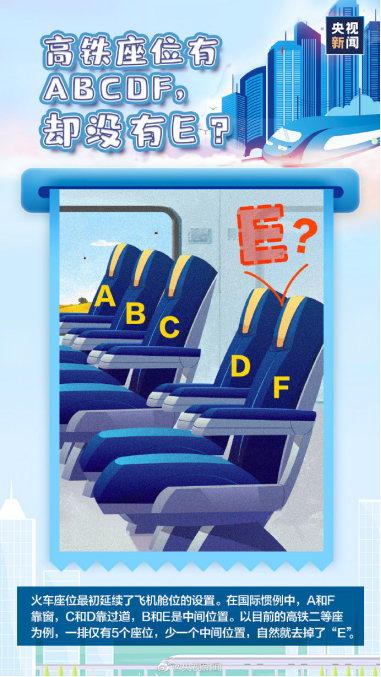高铁上没有e座位(高铁上为什么没有E座)
- >
- 话题 >
- 高铁上没有e座位
- 高铁上为什么没有E座
高铁上没有e座位(高铁上为什么没有E座)
表妹坐高铁回老家,路上发过来一个问题:
高铁座位有A、B、C、D、F,为什么没有E ??
E惨遭“抛弃”,是和英语数字13(thirteen)一样,有什么忌讳吗?
这真是个好问题。其实央视新闻官微曾做过一次科普,介绍到这是一个简单的布局学问。

火车也好,高铁也好,座位都是延续了飞机舱位的设置。
而早期的飞机多是单通道的,一般每排有6个座椅,分别是A、B、C、D、E、F。如下图所示,这样的布局就形成了:A、F靠窗;C、D靠过道;B、E是中间位置。

久而久之,A-F这六个字母就不再单纯只表示顺序,还各自含有区分靠窗、过道与中间座的意思,成了一种惯例。
中国高铁作为后来者,每排的座椅一般也不会超过6个,于是就延续了这种所谓的“国际惯例”。
以目前的高铁二等座为例,采取的都是“3+2”的座椅排列,也就是有2个靠窗,2个过道、1个中间座,所以自然就去掉了“E”,只有A、B、C、D、F。

高铁一等座,采取的是“2+2”座椅排列,2个靠窗、2个过道,也因此只剩下A、C、D、F了,没有代表中间座的“B”和“E”。
高铁商务座,采取的“2+1”座椅排列,2个靠窗、1个过道,也就用了A、C、F表示。
当然了,不管基于何种缘由,这样的排列最终是方便了乘客的。因为当我们拿到票,一看座位号就知道,到底座位是靠窗、靠过道,还是中间位置啦~
借着这个话题,小浅来讲讲“高铁”英语该怎么说。
“高铁”官方译为China High-speed Railway,可缩写为CHSR。
而“动车”则被译为China Railway High-speed,简称CRH。
speed/spiːd/是“速度”,high-speed就是“高速的,快速的”。无论是“高铁”还是“动车”,在外国人看来都是高速列车,都是high-speed train。
另外,动车组列车还经常被称为bullet train。
bullet/ˈbʊlɪt/ 是“子弹”;bullet train即“子弹头列车”,这是一个很形象的叫法,我们可以看到,动车车头就像子弹头一样。
而动车或者高铁之所以被称为bullet train,可能是参考了日本新干线的叫法。日本的新干线列车因为车头也像子弹头,也叫被做bullet train。
小结一下,“高铁”英语可以说:
China High-speed Railway(官方翻译)
high-speed train(高速列车)
bullet train(子弹列车,高铁)
老规矩,最后再来读一篇四六级/考研难度的文章:
China's highways and railways rank first in the world
CRI News Report(节选)
The latest figures from the statistics bureau show that China had 130-thousand kilometers of operating railway by the end of last year.To put that in context,the country's rail network is now 5-times longer than it was back when the People's Republic of China was founded in 1949.
国家统计局的最新数据显示,截至去年(2018年)年底,中国铁路运营里程已达13万公里。相比之下,中国现在的铁路网比1949年新中国成立时增长了5倍。
拓展词汇
by the end of到…为止【例句】He had finished his great works by the end of 1980.到1980年底, 他已完成了他的巨著。
CET4 考研 IELTS TEM4 TEM8
bureau/ˈbjʊə.rəʊ/ n.
①书桌(英式英语) a piece of furniture with a lid that opens to form a writing surface书桌
②(搜集或提供信息的)办事处,办公室,机构an organization or a business that collects or provides information
③(阅批部门的)局,处,科(美式英语)mainly US -a government organization【比如】the Federal Bureau of Investigation 联邦调查局
China is also home to the world's largest high-speed railway network,which had more than 30-thousand kilometers of track in service at the end of last year.I n terms of roads,China now has a network that stretches for 4.9 million kilometers,a 59-fold increase from 1949.This includes 140-thousand kilometers of expressway,the world's largest network of its kind.
中国也拥有世界上最大的高铁网,去年年末,高速铁路的营业里程已超过3万公里。公路方面,中国公路网络达到490万公里,比1949年增长了59倍。其中高速公路总里程超过14万公里,居世界第一。
拓展词汇
be home to某地是……的所在地/出产地/聚集地to be the place where that thing is located or, in the case of living things, where they live
Since the 18th National Congress of the Communist Party of China,the central government repaired 1.3 million kilometers of road over a five-year period.But the most dramatic change has taken place in air travel,with the total length of scheduled flights reaching 8.4 million kilometers,734 times higher than the distance traveled by air in 1950.
中共十八大以来,中央阅批连续五年修复了130万公里的公路。但最引人注目的变化发生在航空业上,定期航班的总航程达到840万公里,比1950年末增长734倍。
Hu Siji,a professor with Beijing Jiaotong University,is in his 80s.He has witnessed the changes to the country's transportation over the past 70 years,and said that investment in transportation infrastructure has helped to boost China's economic growth.
胡思继(音译)是北京交通大学的教授,他今年已经80多岁。他亲历了新中国70年交通事业的变迁,他说,交通基础设施的投资与建设,已经成为中国经济稳定增长的助推器。
高考 CET4 考研 IELTS TOEFL TEM4
witness/ˈwɪt.nəs/v./n.目击(者),看到(尤指事故或犯罪)to see something happen, especially an accident or crime【例句】Did anyone witness the attack? 有人看到那次袭击了吗?
【近义辨析】testimony, evidence, proof, witness都有“证据、见证”的意思,区别是:
testimony: 指证据、证词,多系法律用语。
evidence: 普通用词,在法律上指能起证明作用的,如证明、公证书以及所有的实物东西等。在生活中指任何一样可证明某一件事的真实性的东西。
proof: 指足以直接证明某事为某事实的依据,侧重作为充分证据所导致的结果。
witness: 指证据或证人,尤指后者,且有亲眼见到之意。
"First of all,transportation is all about infrastructure construction,which requires heavy investment.As a result,it can fuel the country's construction investment.Second,before the reform and opening up,the development of the road network had been advancing unevenly.Now,the country is promoting the rational layout of road networks in a bid to make the development of the national social economy more balanced."
“首先,交通是基础设施建设,需要大量投资。因此,可以促进国家的建设投资。第二,改革开放前,路网发展不均衡。现在,国家正在促进道路网络的合理布局,来使国家社会经济均衡发展。”
- 发表于 2021-07-24 01:44
- 阅读 ( 374 )
- 分类:互联网